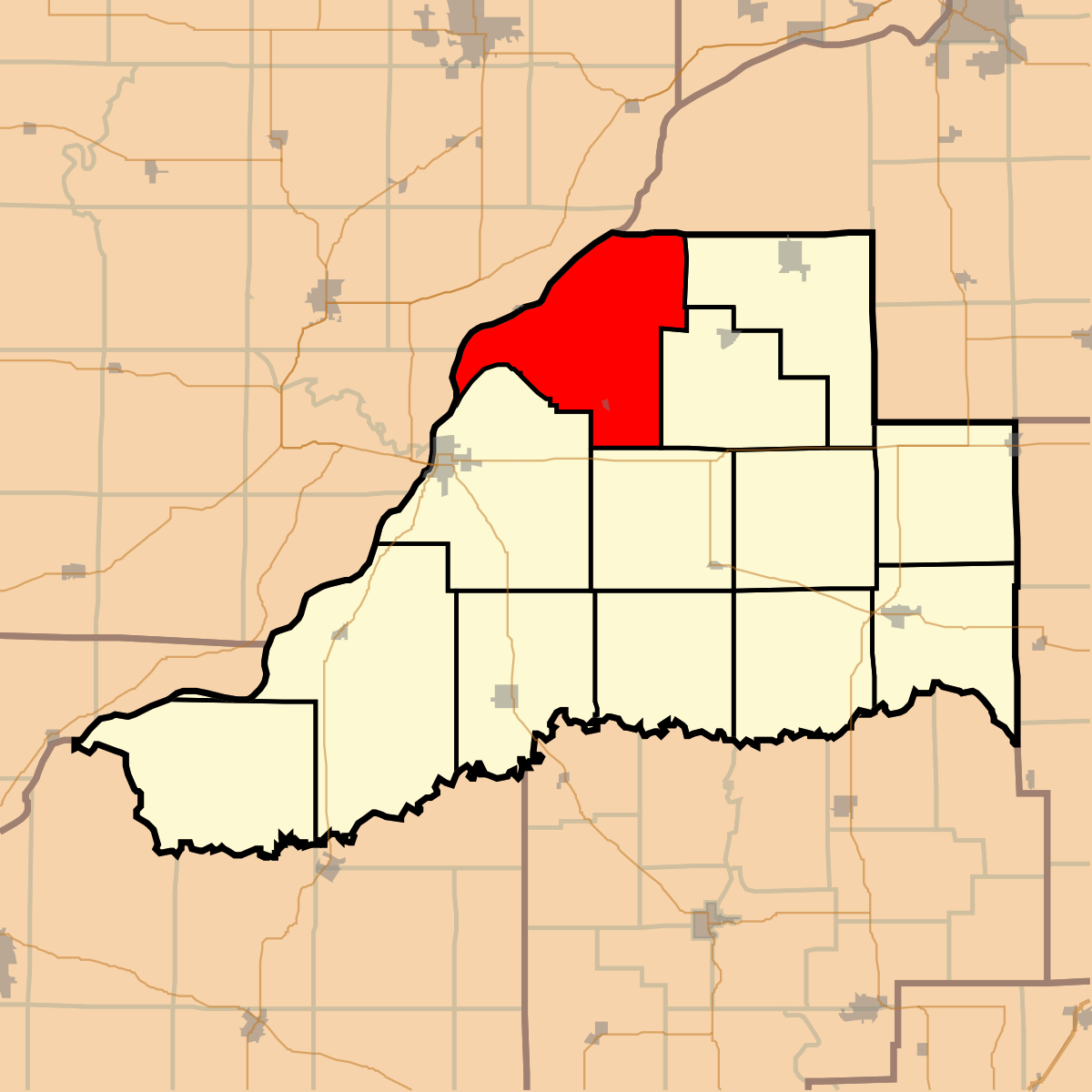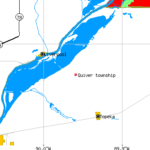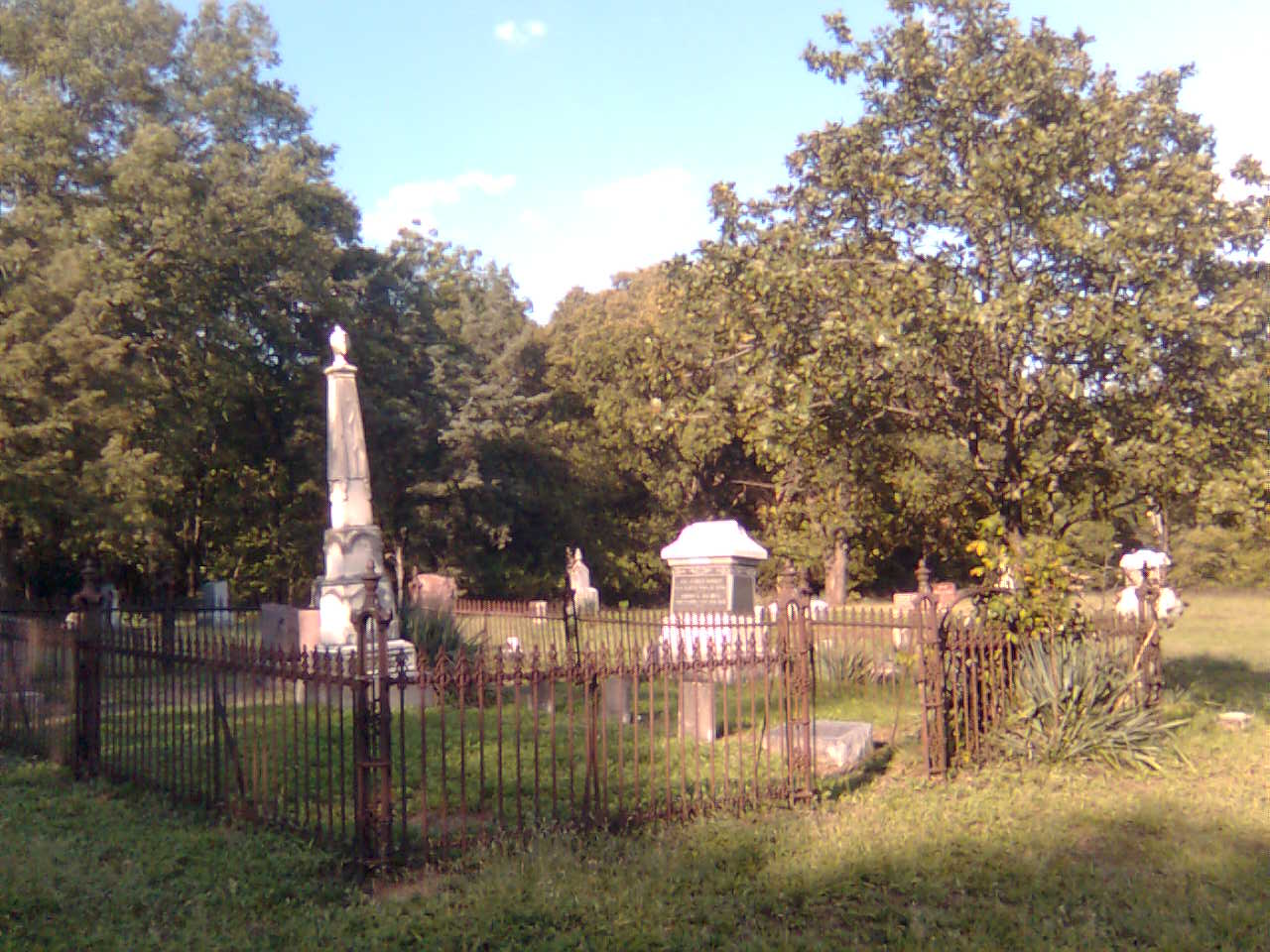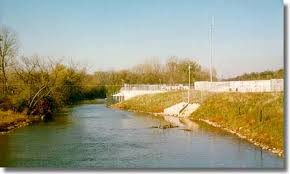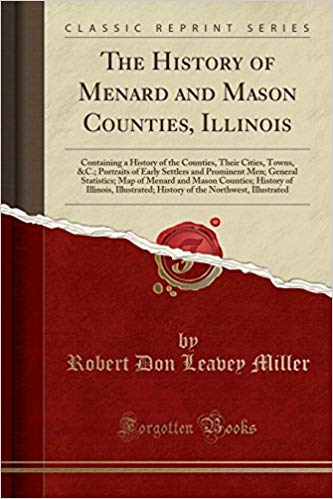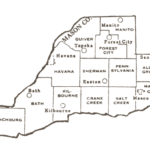next week: Forest City Township
SALT CREEK TOWNSHIP
WILLIAM F. AUXIER, farmer and stock-raiser; P. O. Mason City ; was born
in Floyd Co., Ky., Jan. 26, 1834 ; from the age of 14 to 18 years, he followed boating on the Big Sandy and Ohio Rivers ; all the schooling he received, he got in about three
months, under immeasurable difficulties, though he is now a well-informed, self-edu- cated man, having an excellent faculty of expressing and elucidating any subject, on
any and all occasions ; in business, he has always been successful ; in 1852, he came to Mason Co., and worked here and there farming and herding cattle for wages, until 1855 ; he then commenced on his own account, and in 1856, he took his first lot of fat
cattle to New Yor-k City, being the first ever shipped by cars from Salt Creek Township. Oct. 25, 1859, he married Mary A. Denham ; she was born in Hamilton Co.,
Ohio, in 1839 ; they have three children Emma, born March 20, 1861 ; Clark, Dec.
27, 1863; Cora, Dec. 15, 1865. He owns 400 acres of good land in Salt Creek Township.
ISAAC BELLAS, farmer ; P. 0. Mason City ; was born in Luzerne Co., Penn.,
March 2, 1820 ; his advantages for a common-school education were fair for those
days ; several winters he engaged in teaching district schools, and in the summer worked
at farming. Before he moved West, Nov. 21, 1846, he married Miss Dorcas Benscoter ; she was born in the same county March 17, 1827 ; they moved to Mason Co.,
111., in April. 1854; he worked by the day, farming, until fall, when he put in a crop
of wheat for himself; the next spring, he bought the place where he now resides, in Salt Creek Township ; he has never taken any active part, politically, but has held some
township offices twice Assessor, Collector six years, and School Director ten years ; was elected Justice of the Peace once, but declined the office ; they have had eight
children James, born Oct. 4, 1847, died Sept. 15, 1849; Monemia C., born Sept. 6,
1849, died Oct. 8, 1852; Dyson B., born Jan. 17, 1853, died April 1, 1862; Susanna
E., born May 5, 1857; Sarah A., Dec. 28, 1860, died April 8, 1869; Mary J., born
Aug. 7, 1863; Ross, Feb. 25, 1866; Rosa A., Nov. 19, 1868. He owns a nice farm
of 120 acres; is a Republican, and belongs to the Order of Red Men, in Mason City.
AARON A. BLUNT, President of the First National Bank of Mason City, farmer
and stock-ra iser ; P. 0. Mason City; was born in Hart Co., Ky., Feb. 21, 1831, and
moved to Field’s Prairie, in what is now Bath Township, Mason Co., with his parents, Dec. 6, 1833 ; since his early youth, he has given his attention mainly to farming and
stock-raising; has been a Director in the First National Bank of Mason City since its organization, and was elected its President in February, 1879. He married Martha
Ann Trailer Feb. 26,1852; she was born in Springfield, 111., June 23, 1831; they
have had nine children Laura, born Dec. 12, 1852, died Sept. 18, 1853; Hiram M.,
born March 2, 1854, died June 20, 1855 ; Stephen L., born Sept. 25, 1856; Sinai E. r Jan. 3, 1859; Franklin D., Feb. 23, 1861, died Sept. 30, 1863; Lydia A., born May
9, 1863; Mary I., Nov. 6, 1865; Juliette A., Sept. 21, 1868, died Aug. 10, 1870;
Alonzo A., born March 23, 1872. Mr. Blunt united with the Baptist Church Dec.
16, 1849; was ordained to the ministry, and has held the pastorate of several churches.
His father, Thomas F. Blunt, was born in Kent Co., Md., July 24, 1800, and moved
to Kentucky in his boyhood. Feb. 26, 1822, he married Sinai F. Alderson, of Hart
Co., Ky.; they had eight children, four of whom are living Aaron A., the subject of
this sketch, Lydia F., Hiram and Thomas R. In the fall of 1831, he moved to Cal- away Co., Mo., and in 1832, to what is now ‘Mason Co.; Dec. 6, 1833, he was an
organic or charter member of the Mt. Zion Baptist Church, and is the only male charter member now living in the county; in 1849, unaided and alone, he built a house for school and church purposes, and at his own expense provided a teacher for the ensuing
winter; he bought and used the first power threshing machine, also the first reaper ever used in Mason Co.; the 17th of August, 1872, had an attack of palsy of his right
side, from which he has never recovered. Though infirm and aged, he is living happy
and contented with his youngest son, Thomas R., at Field’s Prairie, in Bath Township,
Mason Co.
HENRY C. BURNHAM, farmer; P. 0. Mason City ; was born in Hampton,
Conn., Jan. 30, 1826. He was educated at home, and also furnished the advantages of
high schools and academies abroad. At the age of 19, he moved to Champaign Co.,
Ohio, and engaged in teaching school for awhile, and finally entered the mercantile business, which being too confining, he sold out and returned to Connecticut. He there
married Miss Angeline Currier Dec. 1(5, 1847. She was born in Genesee Co., N. Y., Dec. 16, 1825.. Her father, Elisha Currier, married Mary Blaisdell Oct. 9, 1817, in New Hampshire, and, in 1823, they moved to Naples, N. Y. Her mother died ( in Woodstock, Ohio, May 15, 1868, aged 73 years ; her father still resides in Woodstock,
in the 87th year of his age. Mr. Burnhani came to Illinois in the fall of 1852, and
settled in Salt Creek Township ; he is a member of and Master of Mason City Lodge,
No. 403, A., F. & A. Masons ; he has been Associate Justice of the County Court ; Treasurer of the school fund many years ; is Supervisor ; though in no sense has he ever been an office-seeker. They have seven children Lora M.,born Oct. 16, 1848 ; Alonzo
F., June 29, 1853 ; Rose A., Oct. 8, 1855 ; James E., January 9, 1857 ; George T.,
Aug.^20, 1860 ; Henry P., Dec. 7, 1862, and Caroline A., July 4, 1866. He owns a fine farm of 320 acres, and a good substantial home with modern improvements and comforts.
ABRAM CEASE, farmer and stock-raiser ; P. 0. Mason City ; was born in Luzerne
Co., Penn., June 6, 1824; he followed farming and lumbering. Married Ellen Wandel
Feb. 13, 1847 ; she was born in the same county Dec. 28, 1826. Her father, James
Wandel, was also born in that county May 3, 1790, and married Lucy Tilbury, who
died May 22, 1854, aged 61 years 10 months and 26 days. She was buried in Pennsylvania Township. James Wandel died in Luzerne Co. while on a visit to his old home,
Feb. 18, 1874. During his lifetime in the Eastern wilds, and on the Western prairies,
he was a great hunter ; many a noble buck, bear, wolf, catamount and fox, and smaller game
have succumbed to his unerring aim. Mr. and Mrs. Cease moved to Mason Co. in May,
1849 (her parents came a year later), and entered land in what is now Pennsylvania
Township. In the spring of 1851, they moved a granary building (thirteen miles),
which was 10×12 feet, on to their farm on Pennsylvania Lane, in which they (family of five persons) lived while they erected a house, which was the first built on Pennsylvania
Lane. They moved into it Sept. 15 following. That season they raised corn ; in the
fall sowed wheat; so they were comfortably fixed in their pioneer home. In 1867, sold their farm and moved to Mason City, and, in 1878, moved to their farm where they now reside, in Salt Creek Township. They have had ten children Elvira, born March
5, 1848, she married Schuyler J. Ross ; Eliva, Aug. 28, 1849, she married William
Stickler; Emma J., Nov. 16, 1850, she married Simon Stickler; Henry B., born Sept.
21, 1852. died Nov. 8, following: Mary M., born April 8, 1854, died Nov. 14, 1855 ; Charles W., born June 26, 1855 ; Frances L., Nov. 29, 1857, she married Isaac W.
Hendry; George A., March 2, 1860; James P., born Feb. 8, 1863, died Nov. 26, fol- lowing; and Oscar J., born June 16, 1865. They own a fine farm of 240 acres, also two houses and lots in Mason City. In politics, he is a Democrat.
GEORGE W. ELY, farmer; P. 0. Mason City; was born in Batavia, Clermont
Co.. Ohio, Feb. 11, 1820, where he followed market gardening. He married Lydia C. Noble July 27, 1846. She was born in Bethel, the same county, Feb. 26, 1826. They
moved to Cass Co., LI., in the spring of 1854, and to Mason Co., where he now resides, in the fall, on to his own farm. His father, George Ely, was born in New Jersey, and
married Mary Maunt in New Jersey. They moved to Clermont Co., Ohio, at an early
day ; lie bought land, and laid out Batavia on his farm ; he kept a hotel, and was Sheriff of the county a number of years. Mr. G. W. Ely commenced farming here under a cloud of unfavorable circumstances, largely owing to the breaking-out of the rebellion,
being in debt, having to pay exorbitant interest (18 per cent), his corn bringing only 8
to 10 cents per bushel, but energy and perseverance have enabled him to overcome and
rise above all these troubles, and place him and his in comfort and independence. They
have five children Sarah J., born July 6, 1846; Eugene B., Dec. 4, 1848; George
C., Nov. 8, 1851 ; John H., Sept. 9, 1801 ; James N., May 24, 1863. The first three were born in Newtown, Ohio, aud the other two in Salt Creek Township. He owns a
fine farm of 304 acres, and a good home. In politics, is a Republican.
WILLIAM P. FAULKNER, farmer and stock-raiser ; P. O. Mason City ; was
born in Dearborn Co., Ind., Dec. 23, 1825 ; with his parents, he went to Fulton Co.,
111., Nov. 30, 1838, and, in February, 1839, to Mason Co. In the spring of 1851, he
began farming on his own account; not being worth a dollar, yet his credit enabled him
to buy forty acres prairie land on time, and live in a shanty until they could do better. He married Melissa A. Virgin March 20, the same year; she was born in Ohio Dec. 4,
lS:n. They had five children Thomas J., born Dec. 27, 1852, and died March 8,
1853 ;/ Eliza J., born Feb. 25, 1854, died Aug. 3, 1873; Arabella E., born Feb. 28,
1856, died April 15, 1857; Belle A., born Nov. 6, 1860, died April 28, 1865, and
Francis R., born Dec. 16, 1863. Mrs. Faulkner died March 22, 1877. His second
marriage was celebrated Sept. 5, 1877, with Mrs. Mahulda Phillips, of Mason Co. ; she was born May ,24, 1855. She has, in her union with John M. Phillips, deceased, two
children Walter R., born Sept. 4, 1873, and William K., born Jan. 13, 1875. By
this second marriage, they have one child Ora May, born Feb. 19, 1879. Mr. Faulkner now owns 604 acres of as good land as there is in Mason Co.
DAVID W. HILYARD, farmer and stock-raiser ; P.O.Teheran; was born in Cumberland Co., N. J., April 1, 1827. Married Catharine F. Tomlinson, of the same
county, Sept. 4, 1851 ; her birthday occurred March 9, 1833; they moved to Mason
Co., 111., in March, 1855, and opened a general country store in Salt Creek Township,
but sold it out in the fall of 1856 ; in the spring of 1857, moved to the farm where
they now reside; Feb. 17, 1867, their house was entirely destroyed by fire, and so suddenly, though at midday, they found it impossible to save anything except a very little bedding and personal clotMng. They have had twelve children, viz., Mary E., born
Oct. 15, 1852 (she married Lorenzo F. Chester, and resides in Cass Co., Iowa); Hannah H., born Sept. 11, 1854 ; Preston J. P., June 4, 1856 (lives in Cass Co., Iowa) ; Emer E., Aug. 26, 1858, died Sept. 23, 1859 ; Lincoln Hamlin, born Aug. 26, 1860 ; Edmond F., Aug. 15, 1862; Robert F., March 2, 1865; Emer E., Dec. 10, 1867;
Charles B., Sept. 9, 1869; George H., Nov. 2, 1871, died Aug. 14, 1872 ; Walter R.,
born Feb. 16, 1874, died July 31, 1874, and Joseph L., born Sept. 30, 1876, died
Oct. 27, 1876. In New Jersey, Mr. Hilyard was a member of the I. 0. 0. F., and
in politics is a Republican ; he owns a good farm of 160 acres, and a nice home.
MICHAEL MALONEY, farmer and stock-raiser; P. 0. Mason City; was born
in Westinade Co., Ireland; in the fall of 1854, he landed in New York City; there he
worked at his trade stone-cutting until the next summer ; he then went to Mason
Co., 111., where he worked at farming about a year and a half for wages, then he rented
farm land ; in 1867, he made a small land purchase where he now resides, in Salt Creek
Tuwnship. He married Sarah E. Hadlock, of Mason Co., in 1861 ; they had two
children, viz., Mary A., born Aug. 4, 1862, died March 18. 1866 ; Edward F., born
March 9, 1864, died Sept. 24, 1864; Mrs. Sarah E. Maloney died Aug. 19, 1866.
His second marriage was celebrated March 26, 1867, with Mrs. Sarah A. Auxier ; she was born near Swing’s Grove, in Mason Co.. Dec. 13, 1840; she had four children by
her marriage with Samuel W. Auxier, viz., George W., born July 19, 1855, died Oct.
22, 1864; ‘Mary L., born April 3, 1857, died Sept. 10, 1858 ; John, born July 8, 1860,
and Samuel L., born March 26, 1862. Mr. and Mrs. Maloney have five children, viz., Anna Virgin, born Jan. 31, 1868; Elizabeth E., Nov. 16, 1870; Emma D., March 31,
1872; Thomas L., April 20, 1874, and Sarah May, June 8, 1876. Mr. Malony is serving his second term as School Director, and second year as Commissioner of Highways ; he belongs to the ” Modoc Tribe of Red Men,” No. 14; he owns a fine, wull- improved farm, containing 305 acres.
GEORGE W. MOSLANDER, farmer; P. O. Teheran; was born in Sangamon
Co., 111., May 13, 1844; son of James and Elizabeth Moslander ; they moved to Mason
Co. in 1845. He married Frances E. Douglas, of Fulton Co., Ill , Nov. 11, 1869 ; she was born in Clark Co., 111., Feb. 12, 1848; they have had three children, viz., Lawrence, born July 29, 1871, died July 31, 1872; Ida May, born Oct. 12, 1873; Louis,
June 28, 1875. In August, 1802, Mr. Moslander enlisted in Co. C, of the 85th I. V.
I., for three years’ service; was engaged in the battles of Peiryville, Ky., Stone Rive r, Chickamauga, Lookout Mountain, Kenesaw Mountain, and at the siege of Atlanta,
Ga. ; July 27, 1864, was taken prisoner and taken to Andersonville ; in three months, was removed to the prison in Millen, Ga. ; kept about three months, then to Savanna,
Ga., about six weeks ; he was then taken back to Andersonville, where he was kept till April 29, 1865 ; was then sent to Jacksonville, Fla., and exchanged ; he was given
transportation from there to Annapolis, Md. ; thence to St. Louis, Mo. ; thence to
Springfield, 111., where he got his discharge, in June, 1865. When he entered Andersonville prison, he weighed 145 pounds; when he left it, his weight was reduced to 65
pounds. Comment is unnecessary here. He then returned to his farm in Salt Creek
Township, where he now resides, and owns a fine home and farm of 1 60 acres.
WILLIAM McCARTY, farmer and breeder of blooded Holstein and Jersey
cattle and Yorkshire swine; P. 0. Mason City; was ‘born in Menard Co., 111., Dec. 11,
1845 ; is the eldest son of Thomas McCarty, of Mason City. He married Sarah J. Ely, daughter of George W. Ely, of Salt Creek Township, Dec. 16, 1866; they have
four children, viz., William E., born Sept. 11, 1867; George T., March 14, 1870;
Malinda J., Sept. 25, 1873, and Francis Otis, Feb. 19, 1878. He is working one of
his father’s farms in Salt Creek Township, of 240 acres, and has a pleasant home.
JOHN McCARTY, farmer and stock-raiser ; P. 0. Mason City ; was born in Clark Co., Ohio, April 19, 1836 ; came to Menard Co., 111., with his parents in the fall of 1838 ; in 1839, moved to Mason Co., where he now resides ; has always followed
farming and raising stock; his father and mother moved from North Carolina to Ohio.
Mr. McCarty married Anna Josephine Beck November 14, 1867 ; she was born in Shelby Co., Ohio, March 9, 1847. Mr. McCarty began life with nothing and never had a cent given him ; he now owns a fine home and 1,066 acres of land in Salt Creek
Township and ten acres inside the corporation of Mason City. Is a Director in the
First National Bank of Mason City ; was Commissioner of Highways nine years, but
declined the honor in 1878. He belongs to Modoc Tribe of Red Men, No. 14, of
Mason City. They have two children Onie Bell, born May 7, 1869, and Ida Dell,
born Jan. 10, 1873.
JACOB F. MULFORD, farmer: P. 0. Mason City : was born in Dearborn Co.,
Ind., Aug. 12, 1838; came to Mason Co., 111., in November, 1847. Aug. 1, 1861, he
enlisted in Co. A, 28th I. V. I., for three years’ service ; previously, he enlisted for the ninety days’ call, but was not ordered out unti] after he re-enlisted, as above stated : he received a bullet in his leg at the battle of Shiloh that laid him up about two months ; he was in many other and some serious engagements ; he re-enlisted Jan. 4. 1863, for another three years or during the war, and remained in the service almost a year after the surrender of the last rebel ; was discharged at Brownsville, Texas, April 14, 1866 ; what were le’t of their regiment disbanded at Springfield, 111. He married Miss Clarinda McCarty May 27, 1866 ; she was born in Salt Creek Township Mar?h 18,
1848 ; they have had nine children Thomas E., born April 28, 1867 ; Carrie I., Dec.
5, 1868; Norman 0., March 7, 1870; Effie M., Sept. 14, 1871 ; Rosie E., Jan. 29,
1873; Jacob E., Aug. 22, 1874, died Dec. 26, 1877 ; John H., born June 14, 1876;
William L., Nov. 4, 1877, and the baby, March 12, 1879. Sept. 12, 1874, they
moved to Missouri and remained three years, and then returned to the farm where they now reside in Salt Creek Township.
ALPHEUS P. ROLL, farmer and stock-raiser; P. 0. Teheran; was born in Sangamon Co. 111., Sept. 17, 1830; moved to the place where he now resides in Salt Creek Township in 1851. His father, William Roll, was born in Essex Co., N. J., June
16, 1786, and married Mary Eddy, of the same place; she was born Feb. 18, 1793 ; they moved to Sangamon Co., 111., in 1830 ; he died Aug. 11, 1849, and she died Dec.
6, 1876. Alpheus P., the subject of this sketch, married Mary E. Moslander April 6,
1850, at Bath, Mason Co., 111.; she was born in Cape May Co., N. J., Jan. 12, 1828 ; her father, James Moslander, and her mother, Elizabeth, were born in Cape May Co.,
N. J., he in 1795, she in 1806; they moved to Sangamon Co., 111., in 1840, and to Mason Co. in 1845 ; he died in April, 1849 ; she died Nov. 24, 1876. Mr. and Mrs.
Roll have had seven children L. G., born Sept, 24, 1850, died Aug. 28, 1851 ; James M., born Oct. 7, 1851, died Aug. 24, 1853; John E. and Mary E.^born Sept.
14, 1853; Rosa R., April 26, 1859, died Nov. 15, 1862; Charles H., born Sept. 13,
1863; Sidney R., March 19, 1866. John E. married Phoebe D. Roll; they reside near his father. Mary E. married William Peterson and resides in Cass Co., Iowa. Mr.
Roll owns 360 acres and a very fine home and surroundings complete, also a house and
lot in Mason City.
JOHN Y. SWAAR, farmer and stock-raiser; P.O. Mason City; was born in Scioto Co., Ohio, March 17, 1816 ; from 1829 to 1836, he was engaged in boating on
the Ohio and Mississippi Rivers; moved to Illinois in 1837; although he has ever
since lived within five miles of his present residence in Salt Creek Township, has lived
in Sangamon, Menard and Mason Cos. He mawied Sarah R. Powell, of Menard Co.,
Aug. 20, 1840 ; she was born in Ross Co., Ohio, June 4, 1822 ; her father and mother
moved from Kentucky to Ohio, and from there to Indiana, and to Menard Co. in 1825 ; they have had twelve children Henry M., born Aug. 9, 1841 ; Harriet E., Aug. 27,
1843 (married Edward S. Hibbard and lives in Kansas); William M., Nov. 3, 1845;
George H., Oct. 6, 1847 (married Mary E. Engel (deceased June 10, 1879, aged 19
years 4 months and 3 days); Sarah K., born April 6, 1850 (married William Markwell); Alcy J., born Feb. 20, 1852; Samuel P., Sept. 1, 1854, died Sept. 14, same
year; Amanda I., born Nov. 26, 1855; John C., Dec. 21, 1857; Oratia N. and
Letitia A., Sept. 12, 1859 ; Abigail, Oct. 4, 1863. Mr. Swaar and his sons own 640
acres of fine land in Salt Creek Township.
PULASKI SCOVIL, farmer; P. 0. Teheran; was born in Litchfield Co.,
Conn., January 28, 1808; in 1826, he went to Livingston Co., N. Y., bought a sawmill and 300 acres of timber, which he soon sold at an advance, and went to Brockport,
in company with a silversmith and jeweler ; but he soon had the business alone,
and manufactured silverware and sent out peddlers of his wares and jewelry until 1831,
when he moved to Geneva, N. Y., continuing in the same business, with the addition
of dry goods and notions. In July, 1831, he married Sarah Jerome; she was born in Onondaga Co., N. Y., in 1813, and deceased in 1840. In the fall of 1832, betook his broken stocks to Buffalo, N. Y., and opened an auction store; it took three months to dispose of all the goods ; he then went to Cincinnati, Ohio, and commenced the manufacturing of silverware and the jewelry business in general, which he continued successfully five years ; in the spring of 1837, he moved to Havana, in this county, where he
owned an interest in a steam saw-mill, bought the balance of the mill, and went to lumbering generally; this mill burned down in 1841 ; he then went to Waterford, Fulton
Co., 111., and bought an old mill and fitted it up, and, in 1845, he built another ; both of
these were destroyed by fire in 1850 uninsured ; he then went to Salt Creek Township,
where he now resides, and has since followed farming ; the first year, with the help of one man, he broke 120 acres of prairie, from which he got his first crop of fall wheat
.’5,5(1(1 bushels, which may be considered a good yield. The issue, living, of his union
with Sarah Jerome are Louisa, Ellen, George W. and Emily. His second marriage was
with Olive Cross, of Havana, III., in the fall of l842 ; she died in 1845 ; he then
married for his third wife Anna Bordwine, of Fulton Co., 111., in 1847 ; by this union,
they have one son living Benjamin F. His fourth marriage was with Caroline N.
Button, of Connecticut, in 1855; she died in 1860; he then married Mrs. Hannah
Jones June 23, 1862; she was born in Washington Co., Ohio”, Dec. 29,
1832; they have, by this issue, five children living Katie S., Pulaski J.,
Oliver H., Martha L. and Arthur A. By her marriage with Greenberry Jones,
she has four children living William E., Abner, Mary K. and Cornelia Jones. Mr.
Scovil owns 565 acres of splendid land in Salt Creek Township, and a fine home and
surroundings, and 400 acres in Missouri.

